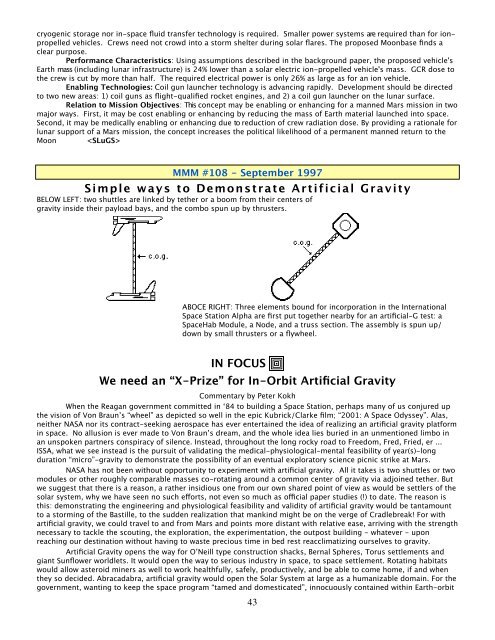Space Transportation - mmmt_transportation.pdf - Moon Society
Space Transportation - mmmt_transportation.pdf - Moon Society
Space Transportation - mmmt_transportation.pdf - Moon Society
You also want an ePaper? Increase the reach of your titles
YUMPU automatically turns print PDFs into web optimized ePapers that Google loves.
cryogenic storage nor in-space fluid transfer technology is required. Smaller power systems are required than for ionpropelled<br />
vehicles. Crews need not crowd into a storm shelter during solar flares. The proposed <strong>Moon</strong>base finds a<br />
clear purpose.<br />
Performance Characteristics: Using assumptions described in the background paper, the proposed vehicle's<br />
Earth mass (including lunar infrastructure) is 24% lower than a solar electric ion-propelled vehicle's mass. GCR dose to<br />
the crew is cut by more than half. The required electrical power is only 26% as large as for an ion vehicle.<br />
Enabling Technologies: Coil gun launcher technology is advancing rapidly. Development should be directed<br />
to two new areas: 1) coil guns as flight-qualified rocket engines, and 2) a coil gun launcher on the lunar surface.<br />
Relation to Mission Objectives: This concept may be enabling or enhancing for a manned Mars mission in two<br />
major ways. First, it may be cost enabling or enhancing by reducing the mass of Earth material launched into space.<br />
Second, it may be medically enabling or enhancing due to reduction of crew radiation dose. By providing a rationale for<br />
lunar support of a Mars mission, the concept increases the political likelihood of a permanent manned return to the<br />
<strong>Moon</strong> <br />
MMM #108 - September 1997<br />
Simple ways to Demonstrate Artificial Gravity<br />
BELOW LEFT: two shuttles are linked by tether or a boom from their centers of<br />
gravity inside their payload bays, and the combo spun up by thrusters.<br />
ABOCE RIGHT: Three elements bound for incorporation in the International<br />
<strong>Space</strong> Station Alpha are first put together nearby for an artificial-G test: a<br />
<strong>Space</strong>Hab Module, a Node, and a truss section. The assembly is spun up/<br />
down by small thrusters or a flywheel.<br />
IN FOCUS<br />
We need an “X-Prize” for In-Orbit Artificial Gravity<br />
Commentary by Peter Kokh<br />
When the Reagan government committed in ‘84 to building a <strong>Space</strong> Station, perhaps many of us conjured up<br />
the vision of Von Braun’s “wheel” as depicted so well in the epic Kubrick/Clarke film; “2001: A <strong>Space</strong> Odyssey”. Alas,<br />
neither NASA nor its contract-seeking aerospace has ever entertained the idea of realizing an artificial gravity platform<br />
in space. No allusion is ever made to Von Braun’s dream, and the whole idea lies buried in an unmentioned limbo in<br />
an unspoken partners conspiracy of silence. Instead, throughout the long rocky road to Freedom, Fred, Fried, er ...<br />
ISSA, what we see instead is the pursuit of validating the medical-physiological-mental feasibility of year(s)-long<br />
duration “micro”-gravity to demonstrate the possibility of an eventual exploratory science picnic strike at Mars.<br />
NASA has not been without opportunity to experiment with artificial gravity. All it takes is two shuttles or two<br />
modules or other roughly comparable masses co-rotating around a common center of gravity via adjoined tether. But<br />
we suggest that there is a reason, a rather insidious one from our own shared point of view as would be settlers of the<br />
solar system, why we have seen no such efforts, not even so much as official paper studies (!) to date. The reason is<br />
this: demonstrating the engineering and physiological feasibility and validity of artificial gravity would be tantamount<br />
to a storming of the Bastille, to the sudden realization that mankind might be on the verge of Cradlebreak! For with<br />
artificial gravity, we could travel to and from Mars and points more distant with relative ease, arriving with the strength<br />
necessary to tackle the scouting, the exploration, the experimentation, the outpost building - whatever - upon<br />
reaching our destination without having to waste precious time in bed rest reacclimatizing ourselves to gravity.<br />
Artificial Gravity opens the way for O’Neill type construction shacks, Bernal Spheres, Torus settlements and<br />
giant Sunflower worldlets. It would open the way to serious industry in space, to space settlement. Rotating habitats<br />
would allow asteroid miners as well to work healthfully, safely, productively, and be able to come home, if and when<br />
they so decided. Abracadabra, artificial gravity would open the Solar System at large as a humanizable domain. For the<br />
government, wanting to keep the space program “tamed and domesticated”, innocuously contained within Earth-orbit<br />
43















